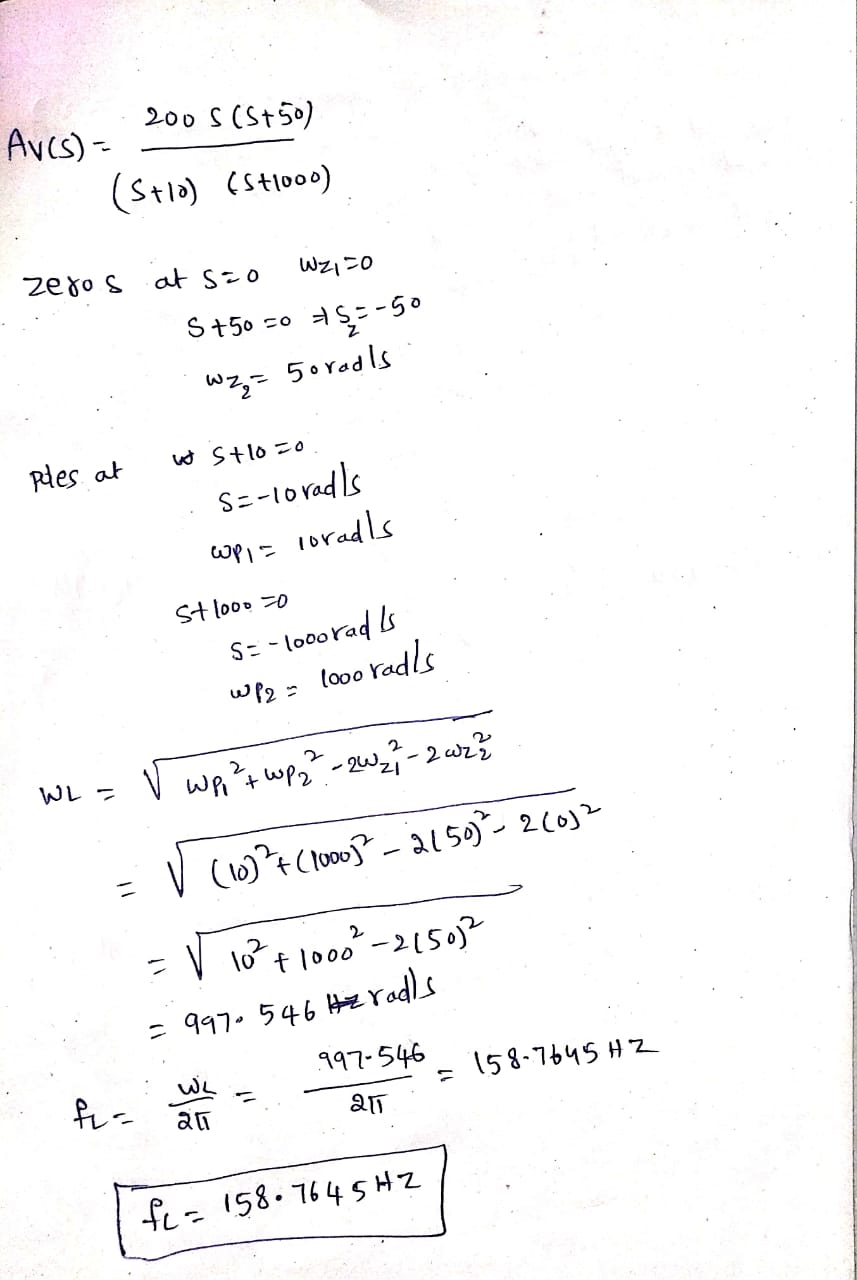
Introductory Circuit Analysis (13th Edition)
13th Edition
ISBN: 9780133923605
Author: Robert L. Boylestad
Publisher: PEARSON
expand_more
expand_more
format_list_bulleted
Question

Transcribed Image Text:EXERCISE: Use Eq. (17.15) to estimate f for the transfer functions:
200s(s+ 50)
100s(s + 500)
(s+100)(s+ 1000)
A,(s) :
Av (S)
and
(s+10)(s+1000)

Transcribed Image Text:Vori + wrz – 2021 -– 2022
WL
(17.15)
Expert Solution
arrow_forward
Step 1

Step by stepSolved in 2 steps with 2 images

Knowledge Booster
Similar questions
- . What is the restriction on the transfer function G2(s) in the system below to obtain zero steady-state error for step inputs if G1(s) is (a) a type 0 TF, (b) a type 1 TF, or (c) a type 2 TF? G2(8) R(s) E(s) 20 C(s) G((s) |s(s+3)|arrow_forwardPLEASE EXPLAIN THE FINAL ANSWER IN WRITTING. PLEASE INCLUDE THE Q, -QL AND QR output latch diagramarrow_forwardA discrete time signal is given by: x(n) = [2, 2, 2, 2, 3] Sketch the following signals : Even Samples of x(n)arrow_forward
- MIMO Exercise: 1) Find the Smith-McMillan form of 1 1 (s+ 1)(s+3) 2(s+1)? Hence find its poles and zeros. 2) Find MFDS of (a) 1 2 s2 +2s+2 (b) 1 -1 1 s? +s-4 2s2 –s-8 (s+1)(s+2) 2s2 -8 Hence find their poles and zeros.arrow_forwardConsider an LTI system S and a signal r(t) = 3e-2¹tu(t — 1). If and if dx(t) dt x(t) System System Determine the impulse response h(t) of S. y(t) −2y(t) + e-³tu(t)arrow_forwardFor the following transfer function please draw the root locus diagram and include all working as well as any asymptotes. Also calculate real axis break in/out points. Include all workingarrow_forward
- Use the definition of the DTFS to determine the time- domain signals represented by the following DTFS coefficients: (a) X[k] = cos(k) = COSarrow_forwardA discrete time signal is given by: x(n) = [2, 2, 2, 2, 3] Sketch the following signals : x(n) u(n-1)arrow_forwardF(s) is the LT of f(t) and is given by: 3s+2 F(s) = s2 +2s+1 Find the initial value of f(t), and then also the initial value of df(t)/dt. Assume f(0+) = f(0-). If F(s) represents a transfer function of some system, what is the DC-gain of that system?arrow_forward
- 5. Write the state space representation of the following transfer function R(s) 8s + 10 C(s) gt + 5²+5? + 5s + 13arrow_forwardI already have figured out how to find the differential equations with these three problems, I am having troubles with finding the Unit Response for each of the systems, mainly the partial fraction decompositions required for it.arrow_forwardhow do you do thisarrow_forward
arrow_back_ios
SEE MORE QUESTIONS
arrow_forward_ios
Recommended textbooks for you
 Introductory Circuit Analysis (13th Edition)Electrical EngineeringISBN:9780133923605Author:Robert L. BoylestadPublisher:PEARSON
Introductory Circuit Analysis (13th Edition)Electrical EngineeringISBN:9780133923605Author:Robert L. BoylestadPublisher:PEARSON Delmar's Standard Textbook Of ElectricityElectrical EngineeringISBN:9781337900348Author:Stephen L. HermanPublisher:Cengage Learning
Delmar's Standard Textbook Of ElectricityElectrical EngineeringISBN:9781337900348Author:Stephen L. HermanPublisher:Cengage Learning Programmable Logic ControllersElectrical EngineeringISBN:9780073373843Author:Frank D. PetruzellaPublisher:McGraw-Hill Education
Programmable Logic ControllersElectrical EngineeringISBN:9780073373843Author:Frank D. PetruzellaPublisher:McGraw-Hill Education Fundamentals of Electric CircuitsElectrical EngineeringISBN:9780078028229Author:Charles K Alexander, Matthew SadikuPublisher:McGraw-Hill Education
Fundamentals of Electric CircuitsElectrical EngineeringISBN:9780078028229Author:Charles K Alexander, Matthew SadikuPublisher:McGraw-Hill Education Electric Circuits. (11th Edition)Electrical EngineeringISBN:9780134746968Author:James W. Nilsson, Susan RiedelPublisher:PEARSON
Electric Circuits. (11th Edition)Electrical EngineeringISBN:9780134746968Author:James W. Nilsson, Susan RiedelPublisher:PEARSON Engineering ElectromagneticsElectrical EngineeringISBN:9780078028151Author:Hayt, William H. (william Hart), Jr, BUCK, John A.Publisher:Mcgraw-hill Education,
Engineering ElectromagneticsElectrical EngineeringISBN:9780078028151Author:Hayt, William H. (william Hart), Jr, BUCK, John A.Publisher:Mcgraw-hill Education,

Introductory Circuit Analysis (13th Edition)
Electrical Engineering
ISBN:9780133923605
Author:Robert L. Boylestad
Publisher:PEARSON

Delmar's Standard Textbook Of Electricity
Electrical Engineering
ISBN:9781337900348
Author:Stephen L. Herman
Publisher:Cengage Learning

Programmable Logic Controllers
Electrical Engineering
ISBN:9780073373843
Author:Frank D. Petruzella
Publisher:McGraw-Hill Education

Fundamentals of Electric Circuits
Electrical Engineering
ISBN:9780078028229
Author:Charles K Alexander, Matthew Sadiku
Publisher:McGraw-Hill Education

Electric Circuits. (11th Edition)
Electrical Engineering
ISBN:9780134746968
Author:James W. Nilsson, Susan Riedel
Publisher:PEARSON

Engineering Electromagnetics
Electrical Engineering
ISBN:9780078028151
Author:Hayt, William H. (william Hart), Jr, BUCK, John A.
Publisher:Mcgraw-hill Education,